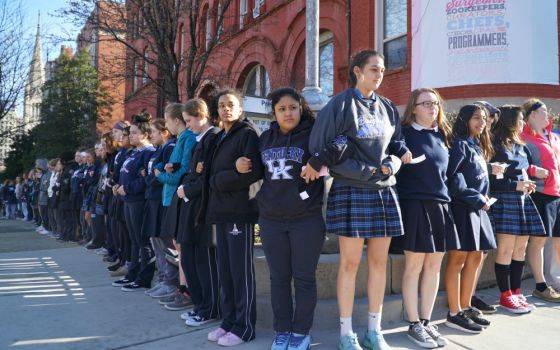
A young woman weeps during a vigil in memory of the victims killed in a shooting May 20 at Santa Fe High School in Texas. (CNS/Reuters/Jonathan Bachman)
A good graph illustrates the point clearly. A really good graph makes us ponder. An excellent graph provides food for contemplation.
Such is the graph in Saturday's New York Times editorial "How Congress Has Dithered as the Innocent Get Shot." The editorial ran originally the day after the Parkland, Florida, mass shooting and reran May 19 with extended data after this past Friday's shooting in Santa Fe, Texas.
The Times defines a mass shooting as an event where four or more people are injured or killed. Since the mass shooting on Dec. 14, 2012, at Sandy Hook in Newtown, Connecticut, more than 1,600 mass shootings have taken place. The Times graph lists the number of shootings month by month and the one date when Congressional action occurred. On 14 days in the past six years, Congress considered introducing or actually introduced a bill or held a hearing — of which nothing came.
On one date — March 23, 2018 — President Donald Trump signed the omnibus spending package that included improved record reporting for the existing background check system. That's it, folks; that's all they did.
This graph haunts me. There's a novel, Blind Your Ponies by Stanley Gordon West, that is really about high school basketball — except that the protagonist, the coach, is a widower because of shooting in a fast food restaurant. I think only three people were killed so even if it were not fiction, it wouldn't make the Times graph. But the novel haunts me, because it shows the damage done inside a survivor and the enormous effort of an entire community to repair the damage well enough to recover enough to see that others are in pain, too, something we can only guess at in real life.
Advertisement
I look back at the graph and imagine the survivors, tens of thousands of survivors of violence that mostly did not have to happen. I am grateful to The New York Times editorial writers who pointed out this massive suffering. I am so grateful to the Parkland high school students who are working to form community to help us take healing action by getting control of guns.
[Mary Ann McGivern, a Sister of Loretto, works with people who have felony convictions and advocates for criminal justice. She lived at a Catholic Worker house for 28 years. She has been a public radio commentator and written plays and a cookbook. She lives in St. Louis.]







